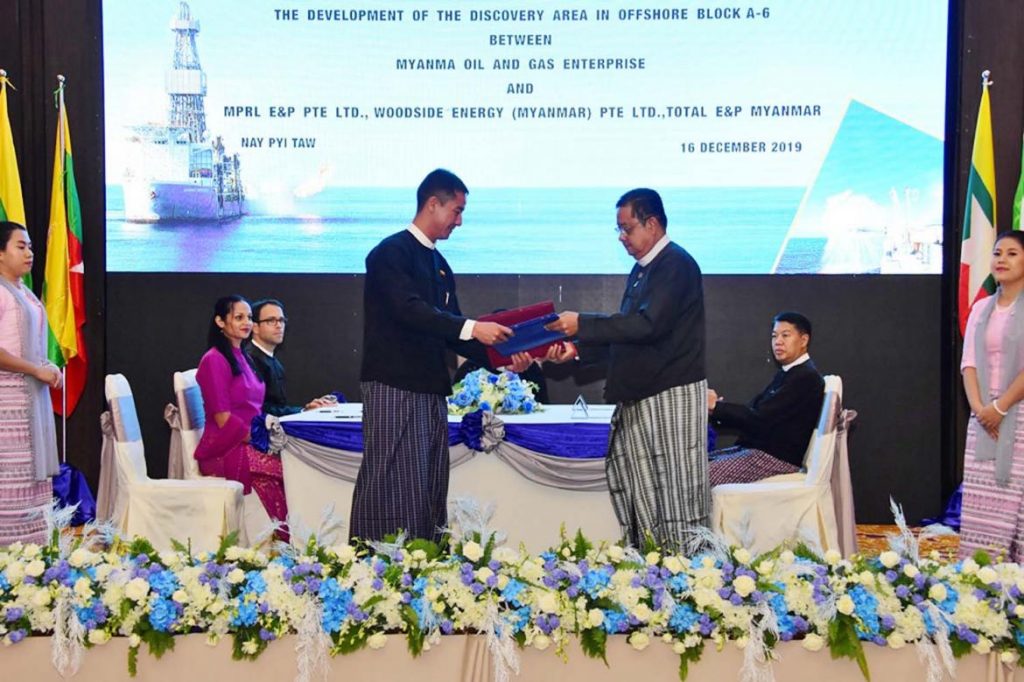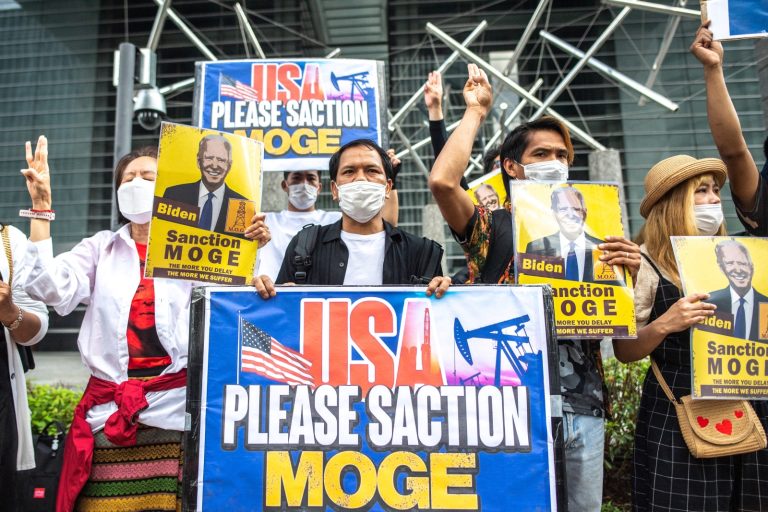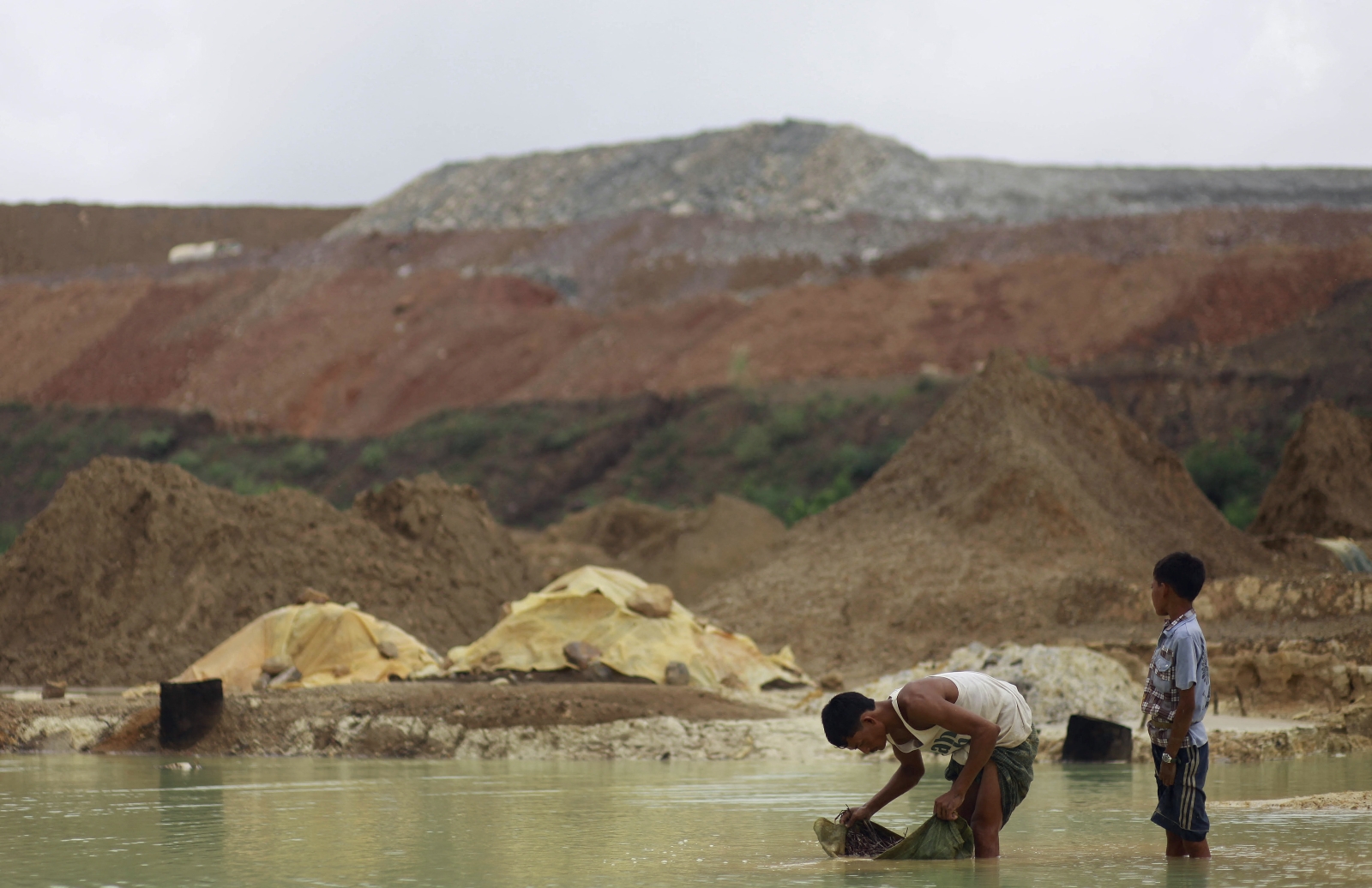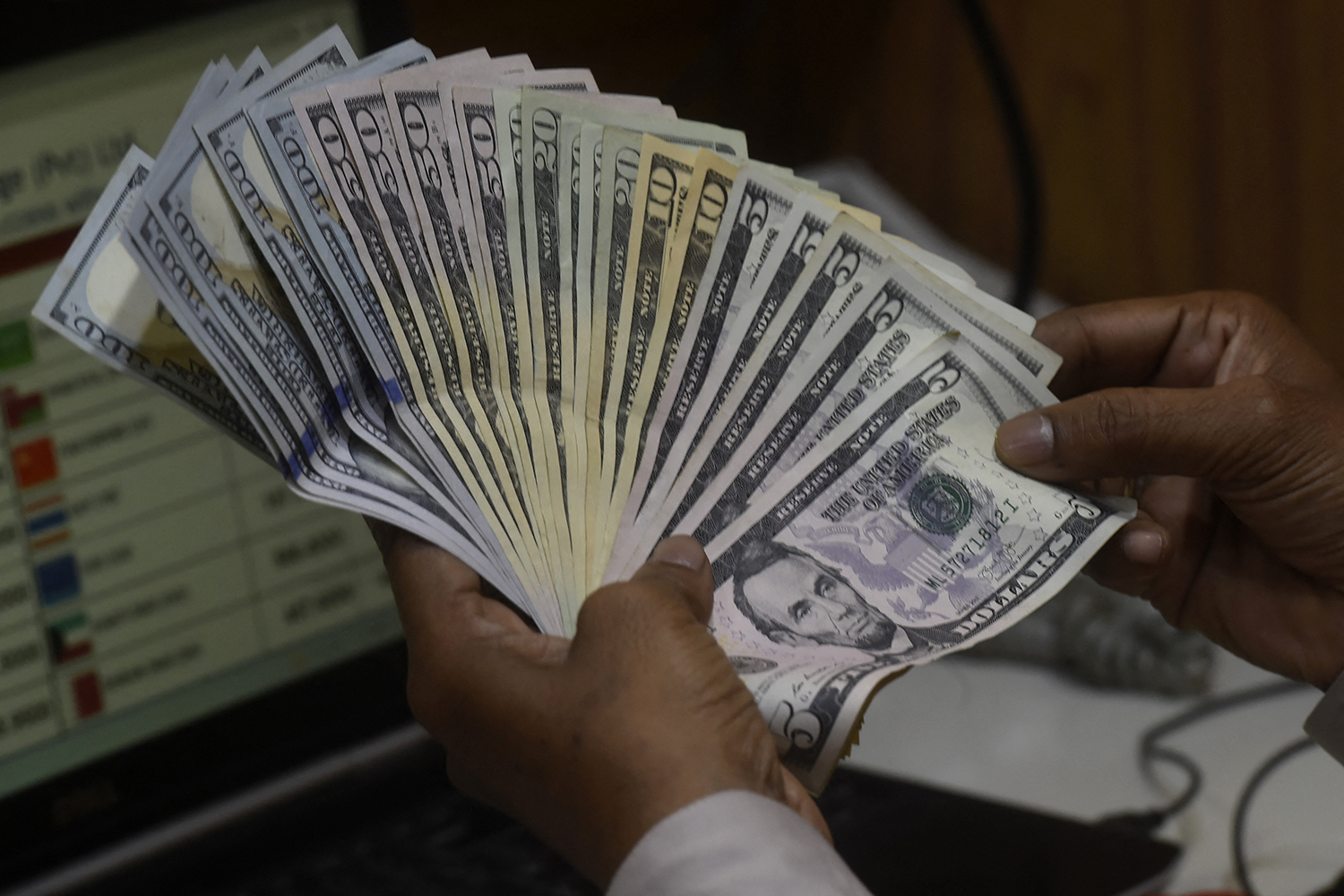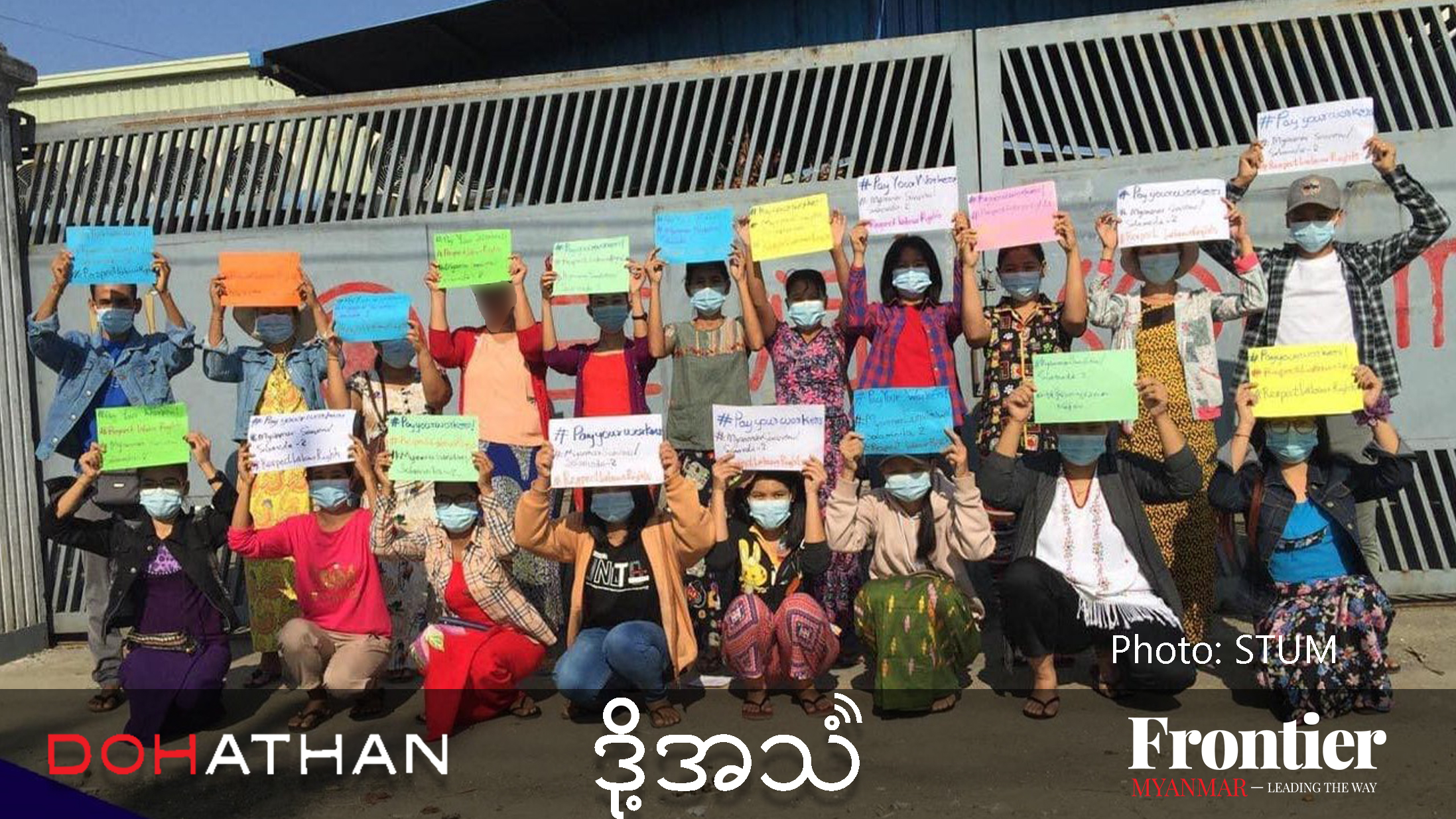The government’s need to secure new supplies of natural gas and a desire to send a positive signal to investors has likely helped a consortium including Total, Woodside and MPRL negotiate favourable fiscal terms to develop the A-6 block.
By THOMAS KEAN | FRONTIER
A RECENT deal between the government and a private consortium to develop a major new offshore gas field comes at an important time for the country, signalling that it is open for business just as production declines at its existing fields.
On December 16, the state-run Myanma Oil and Gas Enterprise signed off on fiscal terms that the consortium – comprising France’s Total, Woodside from Australia and MPRL E&P, owned by Myanmar businessman U Moe Myint – said were necessary to move forward with the project in the A-6 field off the coast of Ayeyarwady Region.
Although the consortium has made several discoveries in the block, which has estimated reserves of 2-3 trillion cubic feet, developing it will be challenging because the gas is more than 2,000 metres below the water. The project will also require a 240-kilometre undersea pipeline so it can link up to existing pipelines to Yangon and Thailand from the Yadana field. The original production sharing contract (PSC) for the field dates to 2007 and is designed for a shallow water block rather than the much higher costs of ultra deep water production.
The deals signed last month – a fourth amendment and supplementary agreement to the consortium’s PSC, as well as an agreement on the upstream and midstream ratio – largely address these issues and enable the consortium to enter what’s known as the preliminary front end engineering and design phase. While a number of hurdles remain, such as negotiating the gas sales agreement, A-6 has moved a significant step closer to entering production.
Support more independent journalism like this. Sign up to be a Frontier member.
The negotiations have been a fine balancing act for the government, which wants more of the gas from A-6 to be used domestically, particularly for electricity generation, than under past agreements.
It also had to give enough ground in negotiations so that the multi-billion-dollar project remained economically viable. With plans to hold another offshore bidding round sometime this year, it would have been a bad outcome for the government if the consortium had delayed the project for a few years or even walked away.
“In the next year we will invite investment in new onshore and offshore blocks and we hope that the oil and gas sector will see more investment,” said Ministry of Electricity and Energy deputy permanent secretary U Htay Aung.
These considerations and the overall complexities of the project mean that negotiations have taken far longer than anticipated; Woodside CEO Mr Paul Coleman told investors at the start of 2018 that the company expected a deal by the middle of last year.
Industry sources said they believe the consortium managed to secure a favourable deal from the government, although the details have not yet been released publicly.
Still, the fact that both sides were able to emerge with a deal to develop A-6 sends an important signal to other energy firms that Myanmar is open for business, even while a number of other issues – such as the PSC for the upcoming bidding round – are yet to be addressed.
“This signing indicates the ministry is willing to compromise,” said Mr Jordan Zele from Myanmar Energy Monitor, a research and analysis service. “This signals to other majors that the PSCs that have hindered the growth of the sector in the last few years can be shifted and will therefore encourage more foreign interest.”
It’s all about timing
Both sides say they are targeting to begin production from the A-6 field off the coast of Ayeyarwady Region by late 2023, with six wells planned for phase one and a further four in phase two.
The target date is no accident. Production at the three existing fields that export gas to Thailand – Yadana, Yetagun and Zawtika – is already in decline, with combined production forecast to soon drop below 1,000 million cubic feet a day.
Overall domestic production will decline rapidly from 2023, according to December 2018 estimates from the Institute of Energy Economics Japan and Ministry of Electricity and Energy, while domestic demand, primarily for electricity and industrial use, is expected to grow steadily.
Unless new fields are soon brought online, this production decline could create serious problems for Myanmar.
Natural gas is Myanmar’s second-highest export earner after garments and the single largest contributor to the national budget, bringing in around US$3.5 billion in the 2017-18 financial year. But it is also used to generate around one-third of the country’s power production, and is the main source during the hot season when hydropower dams run low.
Reaching an agreement to bring A-6 online as soon as possible was therefore essential for the government.
Combined with the government’s desire to send a positive signal to other prospective investors ahead of the bidding round, this gave the consortium greater leverage in negotiations, several sources told Frontier.
MPRL and Total, the joint operators of the field, did not agree to be interviewed for this article.
But Nikkei Asian Review quoted U Sithu Moe Myint, the son of MPRL founder U Moe Myint and the firm’s country manager, as saying that the government “offered more favorable contract fiscal terms in exchange for delivering very early first gas, and in recognition that we have been investing a lot in [exploration].”
Most industry observers though doubt that the extremely ambitious timeline will be possible given the depth of the drilling, and the fact that offshore fields in Myanmar have in the past taken up to a decade to develop.
“We estimate the consortium will be in a position to take a final investment decision by early 2022, with first production expected in 2025 at the earliest,” Mr Andrew Harwood, research director at Wood Mackenzie, told Frontier.
It is unclear whether the consortium will be subject to any penalties if it misses the 2023 target, or how much gas it is supposed to provide by that date.
Meeting power needs
Traditionally, Myanmar has retained little of its natural gas for domestic use. All production from Yetagun is exported, for example, while a maximum of 20 percent from the Shwe field is used domestically, with the rest sent to China.
This has meant that while Myanmar earned healthy revenues from its natural gas exports over the past two decades, it also struggled to meet domestic demand, particularly for electricity.
Myanmar’s priorities shifted following the transition to semi-civilian rule in 2011, which unleashed high economic growth and created a stronger focus on expanding the electricity grid to bring power to the homes of the country’s poorest. But because it hasn’t been able to attract enough investment in new generation capacity to keep up with rising demand, the country is facing power shortages in the years ahead.
Domestically produced gas is economical and gas-fired plants can be built fairly quickly, without the environmental and social costs of coal or hydropower, but A-6 is the only major field that is likely to come online in the next five years or so.
A key question in the recent negotiations then was how to split production from A-6 between domestic use and exports to Thailand.
The PSC for the field dates to 2007, when Myanmar was under military rule, and contains no requirement for any of the gas to be used domestically, several sources told Frontier. But domestic political priorities mean the government has pushed for a relatively high domestic offtake.
For the consortium, exports to Thailand are more attractive because the price is typically higher than that paid by the Myanmar government.
But there’s also a further risk in keeping the gas onshore. Myanmar presently provides around 30pc of Thailand’s natural gas, but if it cannot maintain that supply Thailand may turn to other sources to meet its domestic needs.
Htay Aung from the Ministry of Electricity and Energy said the government had agreed with the consortium to purchase one quarter of the gas from A-6.
“We will get 25 percent of the gas produced from this block for domestic use. It doesn’t have to just be used for electricity – we can use the gas anywhere we need it, based on our judgement,” he said.
But another Ministry of Electricity and Energy official, who asked not to be named, said Myanmar would have the right to buy 25pc of the gas at a 10pc discount, and a further 10pc at market prices.
This is likely less than the government was hoping for, but Zele from Myanmar Energy Monitor said the agreement was important for ensuring security of supply for Thailand.
“With other fields in decline, this agreement will alleviate the fears of Thailand turning elsewhere for its foreign gas,” he said.
But in pushing for a higher share of domestic gas, the government may have been forced to give ground on other important aspects of the PSC, such as the profit-sharing ratio. The typical profit split for a shallow water PSC is 60pc for the government and 40pc for the contractor, while deep-water is 55-45 to compensate for the higher development costs.
Speaking to Frontier in 2018, U Zaw Aung, then director general of the ministry’s Oil and Gas Planning Department, said the fact A-6 was in ultra deep water meant it was a “special case” and up for negotiation.
Attracting investment
The Institute of Energy Economics Japan and Ministry of Electricity and Energy forecasts show that even if A-6 comes online, it will not provide enough gas to compensate for the declining output from existing fields.
That means Myanmar badly needs to attract more investment in exploration. The last offshore bidding round, in 2013, attracted a large number of bids and high signing bonuses, but many winners later relinquished their blocks due to what they considered to be unfavourable fiscal terms amid low global energy prices.
The government has been reviewing the fiscal terms of its PSCs for several years, but no new model contract has been announced.
A newly structured PSC will be essential for attracting interest in a new bidding round planned for later this year, when the government reportedly plans to open 33 blocks, including 15 offshore.
Another issue is the draft Petroleum Law. The ministry reportedly delayed the tender so it could first introduce the law, but according to a recent Asia Times article some in the industry are concerned about the impact the bill might have on the investment climate. In October, the Myanmar Petroleum Operators Club met the Pyithu Hluttaw Bill Committee to discuss their reservations about its contents.
Harwood from Wood Mackenzie said that while the agreements regarding A-6 are a positive step, they are unlikely to allay investor concerns regarding the upcoming bidding round.
“There’s still a lot of uncertainty surrounding the draft Petroleum Law, and the fiscal terms under which any new round will be held,” he said.
He added the industry has also changed significantly since the last offshore bidding round. “The exploration industry is now smaller, but more focused on low cost, high return exploration opportunities that have a clear path to commercialisation,” he said. “While Myanmar’s growing energy demand provides a clear market opportunity, a lack of regulatory improvements in recent years has disappointed upstream investors.”


